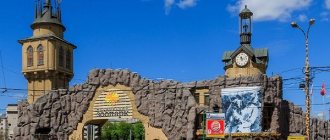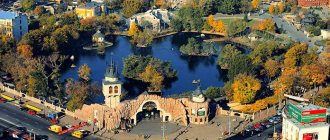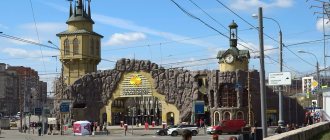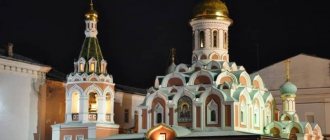Entrance to the Moscow Zoo with a Troika card is possible.
The Moscow Zoo is the first zoo in Russia, opened in 1864. Its creation was initiated by the Imperial Russian Society for the Acclimatization of Animals and Plants, and the zoo was largely maintained by donations from the imperial family. The Moscow Zoo was built according to the design of the architect Campioni, but most of the pavilions arose later. The work of the Moscow Zoo consists of species conservation, research and educational activities.
Now it contains about eight thousand individuals belonging to approximately one thousand one hundred species of the world fauna. The animals of the Moscow Zoo are kept in several dozen exhibitions representing a particular region, family, species, etc. For example, in the Australia section you can admire emus and black swans, and then look into the Giraffe House.
The zoo is a member of the World and European Association of Zoos and Aquariums (WAZA, EAZA), the Euro-Asian Regional Association of Zoos and Aquariums (EARAZA). He participates in many international programs for the conservation of endangered species, collaborating with environmental organizations around the world. There are special excursions for children, seminars and lectures.
Hotels near the Moscow Zoo
Opening hours
Winter schedule:
- daily, from 9-00 to 17-00, ticket offices open until 16-00
Summer schedule:
- from April 1 - daily, from 9-00 to 20-00 (ticket office until 19-00)
- from May 1 to August 31 - daily, from 7-30 to 20-00 (pavilions open at 9-00, ticket offices open until 19-00)
The opening hours depend on the length of daylight hours: in winter, the opening hours of the Moscow Zoo are reduced. Accurate information is published on the main page of the official website of the zoo.
Open lecture hall
The Moscow Zoo hosts lectures for children and adults.
Twice a month on Thursdays at 19:30 lectures for adults are given by scientists, ecologists and popularizers of science. Admission is free, but advance registration is required. The schedule is updated and can be found on the website.
Children's lectures take place on Saturdays at 12:00 and 14:00. Zoologists, oceanologists, ecologists and other scientists talk about a boundless and amazing world. Most lectures include animal demonstrations and are designed for children aged 6 to 12 years. Cost and schedule of classes.
Ticket prices
Zoo ticket prices for adults in 2021:
- weekdays - 600 rubles
- weekends and holidays - 800 rubles
Tickets can be purchased both at the box office and online on the official website. Electronic tickets are sold only the next day, there are no same-day sales. On the day of your visit, the electronic ticket must be exchanged for an entrance ticket at the box office.
Free entry:
- children up to 17 years old inclusive (from 14 years old with presentation of a passport)
- pensioners
- full-time students of educational institutions of primary, secondary and higher levels
- disabled people
- conscripts
- combatants
- families with three or more children
Preferential categories of visitors must obtain a free ticket at the box office to enter the territory.
The following exhibitions are paid separately:
- “The Amazing World of Reptiles” - 300 rubles
- "Exotarium" - 200 rubles
- Greenhouse, tropical butterflies, amphibians - 300 rubles
- “Arachnolandia” - 300 rubles
Pony ride - 300 rubles.
Official website: moscowzoo.ru
Help phone
Pony Club of the Moscow Zoo
The children's “Pony Club” at the stables of the Moscow Zoo opened in 1996. This is the only sports and theatrical pony club in Russia. Today, 120 children aged 7 to 14 years study here. Over the 15 years of work at the pony club, more than 1,500 young athletes have received free training. Since 2000, athletes of the Moscow pony club regularly become prize-winners of all pony club competitions, holding the title of champions of Russia in all types of equestrian sports, including driving.
Pupils of the Moscow Zoo pony club perform in theatrical performances at the Olimpiysky Sports Palace, at the international exhibitions "Equiros" in Sokolniki, at the international equestrian club "Pradar", at exhibitions "LenExpo", at international Akhal-Teke rallies, at the Central Moscow Hippodrome.
© Moscow Zoo / Moscow zoo VKontakte
History of the Moscow Zoo
The Moscow Zoo was founded in 1864 by the Russian Imperial Society for the Acclimatization of Animals and Plants, and is one of the oldest zoos in Europe.
The Moscow Zoological Garden has gone through many difficult times - destruction as a result of revolutionary battles of the early 20th century, difficult post-revolutionary years, bombings of the Great Patriotic War, lack of funding.
Today, the main zoo in Russia occupies an area of 21.4 hectares and houses about 5,000 animals of 1,132 species. The zoo is gradually being repaired and reconstructed, new pavilions and exhibitions are opening, and the collection of animals is regularly replenished with new species.
Plans for the future include equipping all enclosures with video cameras for round-the-clock online broadcasts, reconstruction of the crossing bridge, construction of a new China pavilion, and vending machines with healthy animal feed. A mobile audio guide application with the voice of Nikolai Drozdov and an interactive map is being developed.
How to get to the Moscow Zoo
The oldest zoo in Moscow is located near the Garden Ring, and it is very convenient to get to it by metro, but you can also use ground transport - by bus or trolleybus.
Metro to the Moscow Zoo
The easiest way for city guests to get to the Moscow Zoo is by metro.
At the central entrance to the zoo there are two stations of the Moscow Metro - “Krasnopresnenskaya” (Circle Line) and “Barrikadnaya” (Tagansko-Krasnopresnenskaya Line).
| Metro | Krasnopresnenskaya (Circle Line), Barrikadnaya (Tagansko-Krasnopresnenskaya Line) |
How to get to the Moscow Zoo by ground transport
Stops at the central entrance are “Metro Krasnopresnenskaya” (buses No. M6, T79, 4, 39, 64, 69, 116, 152, 850, 869, trolleybus No. 66) and “Metro Barrikadnaya” (bus No. 11b , trolleybus no. 66).
The stop in front of the entrance on Sadovo-Kudrinskaya is called “Malaya Nikitskaya Street”, the required bus routes are as follows: B, T10, T39, 869.
What to see
You can start your tour of the Moscow Zoo from the Old Territory. Main entrance:
A variety of waterfowl found refuge on the large Presnensky pond. Pink flamingos strut in the shallow waters off the shore:
White tigers and jaguars live near the pond in the “Cats of the Tropics” pavilion. And this is what visitors look like from the cheetah’s side:
Samson the giraffe, which enjoys special attention and love from visitors, lives in an old stone pavilion built back in 1892. On the second floor of the Giraffe House there is the recently opened Zoo History Museum.
It's great when you can watch animals without iron bars. Muskox posing for a photo:
Says hello to you:
Funny raccoons:
In the Bird House you can see penguins, a variety of parrots and this wonderful sloth:
A large 600-kilogram eared sea lion seal in the Pinniped Pool:
Three Asian elephants live in a comfortable Elephant House with a shower, fountain, swimming pool, and outdoor walking area.
Semi-dark exhibition “Night World” with small nocturnal animals:
The amazing world of reptiles:
Wolves:
In this corner to the right of the Main Entrance is the fauna of South America: llamas, vicuñas, guanacos, alpacas, large capybara rodents.
On the Old Territory of the Zoo in Moscow there is also a Pony Riding Circle, Arachnolandia - Land of Spiders, Pheasant Farm, enclosures for spectacled bears, tapirs, wildebeests and snow goats, medium-sized cats - leopards and snow leopards, a rock of birds of prey, an exhibition of amphibians, a greenhouse, an exposition “Fauna of Russia”, ostriches, cranes, storks, cassowaries.
You can cross from the Old to the New territory via a transition bridge. In the New Territory there are also ponds - large and small, where pelicans live.
There are always crowds around polar bears:
In the center of the New Territory of the Moscow Zoo stands the Island of Animals. Along its perimeter are Asiatic lions, polar wolves, Amur tigers, Himalayan bears, brown bears, striped hyenas and common jackals. They were all asleep and didn’t want to pose for photos.
The upper part of the Island of Animals is occupied by the Exotarium - an exhibition with marine aquariums and beautiful fish.
A visit to this pavilion is paid separately; the ticket costs 150 rubles. The Exotarium's opening hours are from Tuesday to Sunday, opening at 11-00, closing one hour before the zoo closes.
Turya hill. Magnificent horns of the horned goat:
Camel and visitors:
Exhibition “Animals of the African Savanna” with a walking field for giraffes, zebras, antelopes and ostriches. Nearby is a meerkat family:
Ring-tailed lemur:
About 30 species of monkeys live in the Primate House.
Charming orangutan:
A family of gorillas led by a charismatic male:
Gorilla Kira and her daughter, born July 22, 2021:
Also on the New Territory there is a pavilion with butterflies and insects, otters, harsa, wolverines, a terrarium with turtles, crocodiles, snakes and iguanas, and a stable.
Exotarium of the Moscow Zoo
The Exotarium pavilion of the Moscow Zoo occupies the 2nd and 3rd floors of the Animal Island pavilion, which is located on the New Territory. In the twilight of the Exotarium, brightly lit aquariums appear before your eyes, where the world of a coral reef is recreated. The Exotarium of the Moscow Zoo contains about 100 species of reef fish from the Pacific, Indian and Atlantic oceans.
The large reef aquarium of the Exotarium displays a variety of coelenterates from the Indo-Malayan archipelago. Initially, they were introduced into the aquarium in the form of single small specimens, but today, constantly reproducing, the coelenterates have covered all the decorations of the aquarium. Along with corals and sea anemones, the aquarium contains tridacni and a variety of reef fish, of which the anemone fish and pseudanthias are especially noteworthy.
What else is there at the zoo?
For the convenience of visitors:
- Mother and child room
- Medical Center
- Souvenir shops
- Kiosks with fast food and ice cream, cafes
- Free Wi-Fi
Throughout the year, the zoo on Barrikadnaya hosts holidays - New Year, “Zoo Birthday”, “Tiger Day”, “Bird Day”, “Earth Day”. Excursions and demonstration feedings are conducted. The following projects are working:
- Club of young biologists
- Children's art studio
- Children's biological club "Manulata"
- Children's theater "Tick-tock"
- Lecture hall
- Project "Zoo Readings"
Animals of the Moscow Zoo
The Moscow Zoo is home to about 8,000 representatives of approximately 1,100 species of fauna from all over the world (invertebrates, fish, amphibians, reptiles, birds, mammals). Animals are kept in several dozen exhibitions, which are thematically divided into habitat regions, families, and species.
The public favorites at the Moscow Zoo are the Pallas' cat. This wild cat was even on the zoo's logo until 2014.
A real treat for visitors is to visit the zoo while feeding predators and large animals. A feeding schedule for jackals, pelicans, seals and other animals is available on the website.
List of animals in the Moscow Zoo (with photos)
Red lynx, © Valentina Chugunikhina
Comments (23)
Daria
05/03/2017 at 11:08 |
please tell me how can I buy tickets online?Reply
Tatiana (admin)
05/03/2017 at 16:08 |
Daria, unfortunately, the online service for purchasing tickets on the official website of the zoo is temporarily not working.
Reply
Alexei
05/30/2017 at 16:01 |
Everything is working. The only thing is that you can’t buy a ticket the same day, only for a future date https://tickets.moscowzoo.ru/ru/
Reply
Irina
05/12/2017 at 21:29 |
And in case of loss of a breadwinner, children are admitted free of charge. And mom too
Reply
Beka
05/23/2017 at 03:01 |
The Moscow Zoo is kind of boring, the animals are either sleeping or not, they have to be pulled not one at a time, but several times
Reply
Alexei
05/30/2017 at 16:05 |
Come early and you will see everything. The 3-park is not a menagerie or a circus; the animals there are not specifically sent out to visitors. In the first half of the day, animals are more active, so you can see everything without problems.
Reply
Sarik
05/23/2017 at 03:13 |
In Moscow, the entrance fee to the zoo is 500 rubles, but you shouldn’t go there, it’s boring, you can’t see the animals at all, they’re sleeping somewhere…….
Reply
Alexei
05/30/2017 at 16:03 |
Come early and you'll see everyone. The zoo is not a menagerie or a circus; animals are not sent there specifically to visitors. In the first half of the day the animals are more active, so you can see them all without any problems.
Reply
Alexei
05/28/2017 at 15:14 |
“Preferential categories of visitors do not need tickets - they can enter the territory by presenting a document at the entrance confirming their right to the benefit.”
Preferential categories need to get a free ticket at the zoo ticket office
Reply
Alina
05/30/2017 at 11:59 |
What document???!About the student is provided???!
Reply
Alexey
05/30/2017 at 15:57 |
If the child shows that he is a minor, then a free ticket at the box office will be given without any document. But nevertheless, you will need to get a free ticket.
Reply
Elena
06/03/2017 at 11:51 |
Hello. Will a certificate for a large family be the basis for a free visit to the zoo?
Reply
Julia
06/08/2017 at 18:01 |
Judging by the information, large families have free admission on any day??? In St. Petersburg because they just did the first Saturday. I hope it doesn’t matter where a family with many children comes from: St. Petersburg or Moscow?? We just want to come
Reply
Natalia
07/05/2017 at 20:04 |
Students only need to present their student ID. ticket?
Reply
Andrey
07/23/2017 at 23:47 |
Thanks for the informative article and great photos. It’s like being in a zoo)) But the question arose: what’s the smell like? Usually in zoos it’s not very good... Is it specific here or is it still tolerable? I’m just planning to go with my child, I don’t really want to disappoint him.
Reply
Tatiana (admin)
07/24/2017 at 11:41 |
In some places there is no smell at all, in others there is very little smell. The only thing in the elephant barn, since it is an enclosed space, is that it smells.
Reply
Catherine
07/27/2017 at 19:02 |
For the loss of a breadwinner, is mom free? The child is 5 years old. What document is needed?
Reply
Tatiana (admin)
07.27.2017 at 20:38 |
On the official website of the zoo, the list of beneficiaries does not include “survivorship”. The child will go for free.
Reply
Yuri
09.12.2019 at 18:31 |
I was at the zoo today and was amazed where the animals went; 80% of the cages in the new territory are empty. There are several polar bears in your photo, but today there was 1. The unfortunate elephant (one, not 3 as you write) was indoors and walking on the concrete floor. Previously, as I remember, the elephant was in the fresh air, he walked on the ground and he had a pool. The reservoirs are dirty. Yes, the Moscow Zoo has lost its face, but tickets cost 500 rubles. I won't go there again.
Reply
Iza
05/28/2020 at 20:39 |
Is the zoo open on June 1st? Tickets can be purchased online or sold only at the box office
Reply
ELENA
06/30/2020 at 20:45 |
Can you buy tickets at the box office or only online, are the box office open now?
Reply
Svetlana
07/10/2020 at 20:49 |
Tell me, is it still necessary to take a free ticket at the box office if you are a pensioner?? Or can I use my social card?
Reply
Munya
07/27/2020 at 15:18 |
Hello, please tell me how much does a ticket for children cost? Children age 9 years..
Reply
Marsupials
Pygmy flying squirrel.
Bennett's wallaby - kept in a special glass enclosure.
Large striped couscous – exhibition “Night World”.
The brownie opossum is a solitary animal kept in separate cages.
Partial teeth:
Ball-shaped armadillo - the species is protected in Brazil, the Night World pavilion.
The bristly armadillo is a group of “traveling animals”. They live in an enclosure with sloths.
Two-toed sloth - a male and two females live in an enclosure on the crossing bridge.
Short-legged Elephant Jumper – Night World placement.











